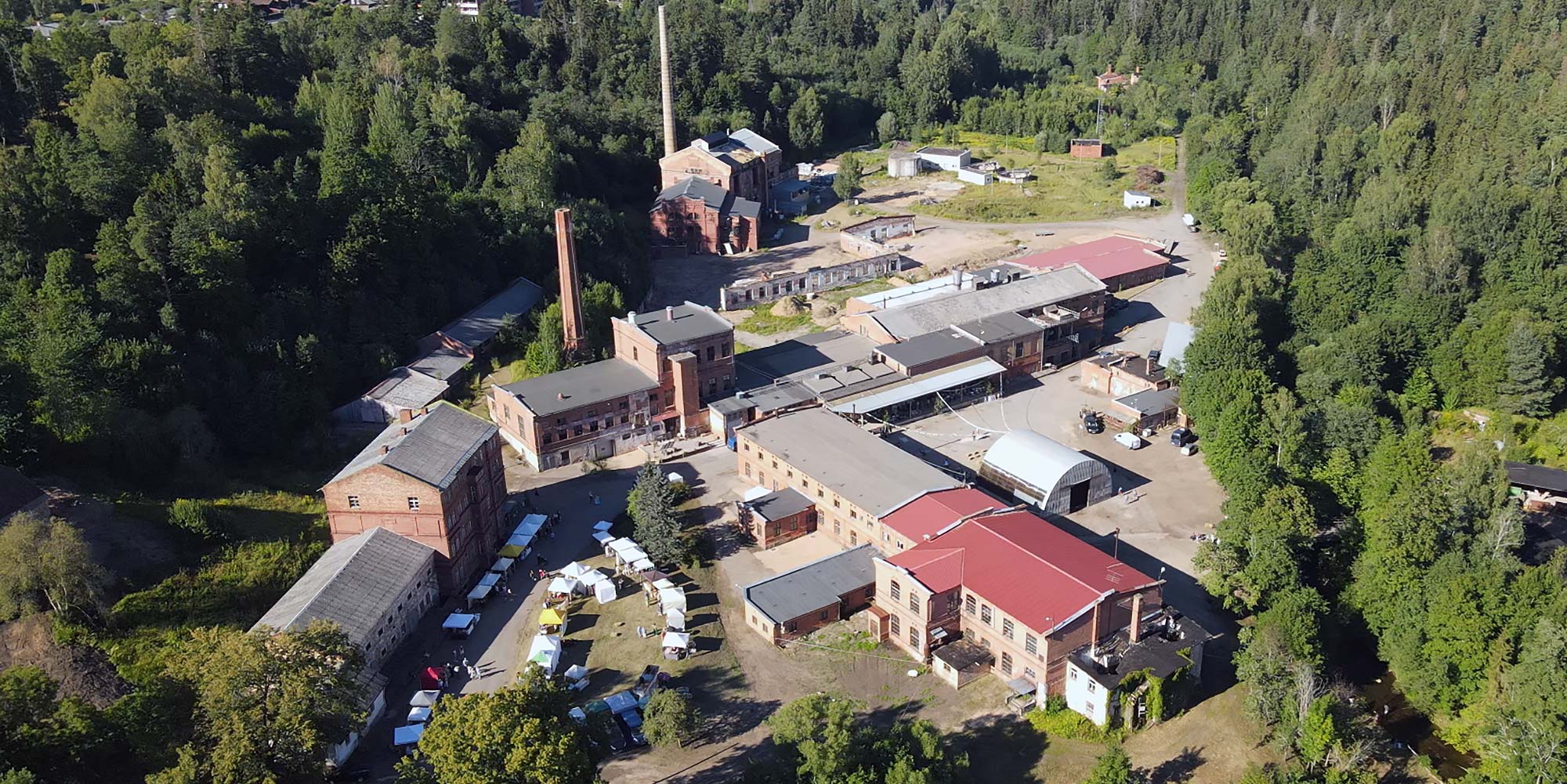History of Ligatne Paper Mill
Founded in 1815, Ligatne Paper Mill is the oldest company in Latvia that works in the paper manufacturing industry and is one of the oldest paper mills in Europe. At some point, it was also the oldest industrial company in Latvia, which operated with almost no interruption for nearly 200 years. Thanks to the Paper Mill, Ligatne town was gradually built around it as a living area for the Paper Mill workers.
The Story of the Paper Mill
On November 13, 1814, Konrads Justus Storhs and Karls Kibers signed a lease agreement for the Paltmale manor mill and the surrounding lands near the Ligatne River. This place was chosen because paper production requires water, and the Ligatne River is the fastest in Latvia. In a year, the gristmill was rebuilt and adapted for paper production. For the production of paper, they built an aqueduct and sluice, as well as dug a canal. In 1815, 15 workers started working at the newly built paper mill, producing 17.19 tons of paper per year under the supervision of the head of the paper production. Until 1849, paper production was done by hand. They made the paper pulp from linen rags by grinding it in a water-powered mill and then poured a.k.a. ladled the paper by hand. In 1849, the first paper machine in Latvia, which was powered by a water turbine, was installed. That was how industrial paper production started.
In 1856, the paper mill was bought by Karlis Grothus, who installed the second paper machine, which was powered by steam. He founded the joint stock company “Ligatne Paper Mill Company” (“Līgatnes papīru fabriku kompānija”). Over the years, the Paper Mill owners changed, but the production was continuously modernized, according to the technological possibilities at the time.
The paper produced in Ligatne was sold throughout Russian Empire. There it was considered the best. In 1879, Ligatne paper received a silver medal at the Russian manufactory exhibition in St. Petersburg. In 1844, the Ligatne Paper Mill burned down, but it was restored within a year, and a new paper machine was purchased from a German company "Hemmer". In 1892, two paper machines started working, and in 1895, there were three working paper machines. In 1894, at the first Russian Empire industrial exhibition in St. Petersburg, Ligatne paper received a gold medal, and a few years later, in 1896, at the Industrial and Art Exhibition in Nizhny Novgorod, Ligatne was granted the rights to display the state emblem on the products. Until 1913, Ligatne produced high-quality paper for important state documents.
During World War I, paper production stopped. All three paper machines were evacuated to Russia, of which only one was partially returned after the war. In 1920, the government of the Republic of Latvia granted 20 million Latvian rubles to renovate the Paper Mill. In 1921 production resumed with one paper machine, but in 1923, a second paper machine was installed, and a third in 1936. Other equipment was also purchased anew, so the Ligatne Paper Mill can be considered a modern company in the interwar period.
In the 1920s and 1930s, Ligatne had the most modern production facilities of the time, and it was one of the most prominent fine paper mills in Europe. The paper was exported all over the world. In the Paper Mill, they produced the finest varieties of paper, as well as paper for technical needs. In addition to writing and printing papers, they also produced cardboard, bank cheque paper, cigarette paper, photo paper, paper for Russian Empire army maps, watermark paper, and other type of papers specific to the world market. They produced around 100 different types of paper from 10 to 600 g/m2. 50-60% of all production was exported.
During World War II, paper production stopped, but in 1945, paper production was resumed on three paper machines. The fourth machine was installed in 1952. In 1974, two paper machines were replaced by new ones, but there can be seen an increase in the technological gap compared to paper-producing countries in the West. There were no investments or technology improvements made according to the standards of the time and available modern technologies. During this time, only 20 varieties of paper were produced, some of them exclusively for the needs of the Soviet Union.
On November 5, 1993, the Paper Mill partially burned down. For its restoration, the residents of Ligatne donated 12,500 Latvian lats, while the Ministry of Forests granted 34,000 lats.
From 1994, waste paper became the main raw material for paper production, producing high-quality drawing and watercolor papers, black paper, and a small amount of paper with watermarks.
Joint stock company "Paper Mill "Ligatne"" was formed on January 26, 2000. One of four paper machines was in operation, producing 12,000 tons of paper a year. The production was focused on packaging paper made from waste paper, recycling approximately 16,000 tons of paper a year. Although the company actively worked on modernizing the equipment and improving the technologies, as well as installing the fifth paper machine, it did not withstand the global competition and was unable to self-finance the function of the Paper Mill. In 2014, the company was closed.
Production process and technology
In nearly 200 years of being in operation, various raw materials, like linen rags, wood pulp, cellulose, and waste paper, have been used in paper production. Initially, when paper was still produced by hand, flax fiber was used. They were obtained by processing used linen fabrics, a.k.a. rags. When paper production was started mechanically, the main raw material became cellulose, which was obtained from wood. The cellulose was boiled to separate the lignin from it. The less lignin, the lighter the paper. To produce white paper, they used bleached cellulose.
Paper Mill also used various auxiliary materials. The most important auxiliary substance is water. Per ton of paper, they needed to consume 20 to 50 cubic meters of water taken from the Ligatne River. Other auxiliary materials such as chalk, kaolin, dyes, glue, and various chemicals worked as fillers. To dry the paper, they used steam. One ton of paper required about four tons of steam. Steam was obtained by burning natural gas that came from Russia. Paper production was a very energy-intensive process. To produce one ton of paper, Paper Mill consumed about 600-700 kWh of electricity.
Until the beginning of the 1990s, Ligatne Paper Mill produced the so-called white paper, which was also known as writing paper, printing paper, drawing paper, and smoking paper. It was produced from bleached cellulose imported from Russia. The specific paper was also exported to Russia, but not to other countries. When Latvia separated from the Soviet Union, electricity prices rose by several hundred times. They also lost the Russian market. Due to these two reasons, Ligatne stopped producing white paper varieties from purchased bleached cellulose. Therefore, the Paper Mill switched to producing paper from waste paper. From recycled paper, Ligatne produced mainly varieties of packaging paper. About 50% of the production was exported.
The process of manufacturing
The paper production from the waste paper was relatively simple. It began with shredding, then grinding, and cleaning of impurities. Then the necessary chemicals were added to the prepared pulp, and the pulp was diluted to a concentration of 0.5 to 1%. The higher the dilution, the smoother and better quality paper could be produced.
The diluted pulp was spread evenly on the paper machine's sieve. A paper machine is essentially a pulp dewatering machine. It consists of a sieve, press, and drying parts. To dewater pulp in the sieve, gravity, special dewatering elements (hydro plates and register cylinder), as well as spacing out caused by a vacuum pump was needed. When leaving the sieve part, the paper belt had about 25% dry material on it. In the press part, dewatering was achieved by pressure-making the material on the paper belt to be around 45% dried. In these two parts, the fibers were joined together, which largely determined the characteristics of the paper. In the drying part, the belt with wet paper wrapped around the cylinders, which were saturated with steam. The cylinder surface temperature was between 60 and 115 °C. After drying, about 7% moisture remained in the paper.
The sieve, press, and drying tubes were made of synthetic material that was purchased in Russia and Sweden. The speed of the paper machine was up to 175 meters in a minute. The machine itself was two meters wide and able to produce up to 45 tons per day. For comparison, the largest paper machines in the world are around 11 meters wide, with a speed of up to 2000 meters in a minute and a power of up to 1800 tons per day.
The peak of production during the interwar period was 6200 tons a year, which was reached in 1937. However, it did not exceed the maximum reached during the Russian Empire time, which was 7091 tons in 1913. The next maximum was reached in 1975, which was 15,600 tons, and then in 2000, which was 12,000 tons.
The Paper Mill workers
From the start, the founders, owners, engineers, and craftsmen of the Paper Mill were only Germans. The first Latvian craftsmen started working at the Paper Mill only in 1934, but Latvian engineers in 1939, when all Germans were repatriated to Germany.
Number of employees by year:
in 1913 – 660
in 1940 – 500
in 1955 – 1000
in 1990 – 600
in 2000 – 150
Paper Mill worker village
As the Paper Mill evolved, the beginning of the 20th century was the time to start the construction of the Paper Mill worker village. The village consisted of residential buildings, a school, a hospital, a pharmacy, a clubhouse, a guest house, a maternity hospital, a nursing home, and other buildings, which have remained to this day. They created a social model that was unique for that time. Workers and administration employees were given free apartments, electricity, heating, medical care, education for children, and care for the elderly. Everyone working at the Paper Mill was provided with good living conditions and everything necessary for work, health, education, and entertainment.
VIDEO: Inara Karklina's Story
VIDEO: Reconstructed memories of Dzidra Steina, a resident of Ligatne


